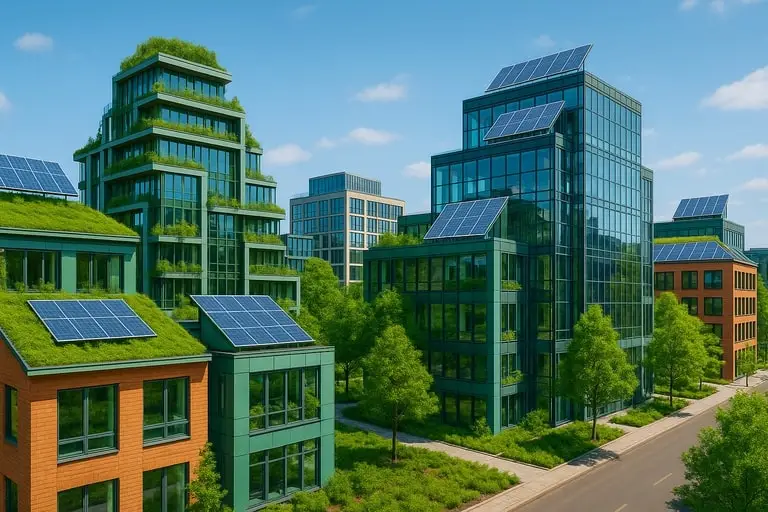The rise of eco-friendly buildings has become one of the most significant shifts in contemporary construction, reflecting a deeper cultural and economic transition toward responsible resource management. Across the world, governments, developers, and communities recognize that the traditional building models of the twentieth century are no longer sufficient to meet environmental and social needs. These structures were often designed with little regard for long-term energy consumption, waste, or their broader ecological footprint. By contrast, today’s eco-friendly approach integrates design principles, technologies, and materials that not only reduce harm but actively promote better human health and community resilience. This evolution is not a niche phenomenon but a global movement reshaping the way cities and towns are planned and lived in.
One of the most defining elements of this transformation is the focus on lifecycle thinking. Instead of assessing construction simply at the design or completion stage, architects and engineers evaluate how every component will perform over decades. From material sourcing to demolition and recycling, every step becomes part of a continuous cycle where waste is minimized and efficiency is maximized. This perspective is not just philosophical; it is driven by measurable metrics that help builders demonstrate reduced emissions, lower energy bills, and improved occupant well-being. These outcomes have become powerful selling points in both residential and commercial real estate, where tenants increasingly demand healthier and more sustainable environments.
Central to eco-friendly buildings is the integration of energy-efficient systems that draw upon both passive and active design strategies. Passive design emphasizes natural ventilation, optimized daylighting, and building orientation to reduce artificial energy needs. Active systems include renewable energy installations such as photovoltaic panels, geothermal heating, and advanced insulation technologies. These strategies, when combined, deliver significant reductions in operating costs and carbon emissions, making them attractive not only for environmental reasons but also for financial ones. As energy prices fluctuate globally, the economic rationale for such innovations becomes even more compelling.
The selection of construction materials has also shifted dramatically under the influence of sustainable design. Instead of high-carbon concrete and non-recyclable finishes, builders increasingly turn to responsibly sourced timber, recycled steel, and alternative composites that balance strength with low embodied energy. Innovations such as low-carbon cement or cross-laminated timber allow for greater creativity without compromising structural integrity. These materials support a more circular economy, reducing dependence on finite natural resources and aligning with global climate targets. Their adoption also stimulates local industries and crafts, creating jobs that further strengthen community resilience.
Beyond materials and systems, eco-friendly buildings are designed to enhance the health and comfort of occupants. Indoor air quality, natural lighting, and thermal comfort are now treated as fundamental considerations, not luxuries. The rise of green certifications such as LEED and BREEAM has accelerated this trend, providing benchmarks that developers strive to achieve. These certifications validate that a building meets stringent requirements in areas like water conservation, waste reduction, and energy efficiency, offering occupants tangible reassurance of long-term quality and safety.
Urban integration plays a vital role in how eco-friendly buildings shape broader landscapes. Rather than existing as isolated projects, they are conceived as integral components of sustainable communities. This means proximity to public transportation, support for cycling and walking infrastructure, and inclusion of green spaces that restore biodiversity in densely built environments. Rooftop gardens, vertical forests, and water management systems demonstrate how architecture can simultaneously address human needs and ecological renewal. Such approaches highlight the potential of the built environment to become a force for environmental regeneration, not just neutral impact.
The global nature of this movement cannot be overstated. From Scandinavian wooden skyscrapers to desert-based passive cooling homes, eco-friendly construction adapts to diverse climates and cultures. Each region applies the principles uniquely, but the shared goal remains: minimizing negative impacts while maximizing long-term resilience. In developing nations, these practices also provide solutions to housing shortages, offering affordable, durable, and healthy homes that uplift quality of life without replicating unsustainable models of the past.
Ultimately, the momentum behind eco-friendly buildings is driven by a combination of necessity, innovation, and vision. Climate change, resource scarcity, and public demand converge to make sustainable construction not only desirable but essential. Yet it is the creativity and determination of architects, engineers, and communities that transform these pressures into opportunities. By embracing eco-friendly construction methods, society is not just mitigating damage but actively crafting a future where the built environment coexists harmoniously with natural systems. This is the real power of eco-conscious design: it reshapes expectations and proves that progress and preservation can walk hand in hand.
Eco-Friendly Buildings And Sustainable Construction Innovation
As construction evolves, eco-friendly buildings demonstrate that sustainability is not a limitation but a catalyst for innovation. Designers are leveraging advanced modeling tools and data analytics to predict building performance long before ground is broken. These simulations account for sunlight angles, wind patterns, and seasonal shifts, allowing architects to optimize efficiency with precision. Such digital integration reduces costly trial-and-error approaches and ensures that new projects meet sustainability targets from the earliest stages. This convergence of technology and design exemplifies how construction adapts to both environmental and economic demands simultaneously.
Equally important is the shift toward modular and prefabricated techniques in sustainable construction. By producing building components off-site under controlled conditions, waste is minimized, quality is enhanced, and timelines are shortened. These systems also allow for greater flexibility in adapting designs to meet evolving sustainability standards. As urban populations expand, modular methods can address the dual challenge of speed and sustainability, delivering eco-friendly housing and infrastructure at the scale required. This represents a paradigm shift from conventional approaches that often sacrificed ecological performance for rapid expansion.
Water conservation has emerged as another defining element of eco-friendly building design. Smart plumbing systems, greywater recycling, and rainwater harvesting ensure that precious resources are managed responsibly. In arid regions, such technologies make the difference between viable urban development and unsustainable sprawl. Globally, this attention to water efficiency helps mitigate the increasing stress on freshwater supplies, aligning urban growth with ecological boundaries. These solutions, once considered niche, are now becoming mainstream elements of modern building codes and regulations.
Another frontier in sustainable design is the fusion of architecture with renewable energy systems. Instead of treating energy production as an afterthought, eco-friendly buildings often integrate solar panels into facades, wind turbines onto rooftops, or geothermal systems beneath their foundations. The building itself becomes a generator, reducing reliance on external grids and enhancing energy resilience. In regions vulnerable to climate disruptions, this independence can provide a lifeline during power outages, further emphasizing the functional benefits of sustainable construction.
The relationship between eco-friendly buildings and human well-being also continues to deepen. Research consistently shows that sustainable offices enhance employee productivity, reduce absenteeism, and foster greater satisfaction. Schools designed with natural light and ventilation improve learning outcomes, while hospitals with biophilic design elements accelerate recovery rates. These tangible benefits make sustainable design not just an ethical choice but a pragmatic one for organizations seeking to improve outcomes for their occupants.
Financial innovation supports these shifts as well. Green financing mechanisms, such as sustainability-linked loans or government tax incentives, make eco-friendly construction more attractive to investors and developers. The long-term operating savings coupled with lower financing costs create a compelling business case. Far from being an expensive luxury, sustainable construction emerges as the financially responsible approach, offering measurable returns across decades of operation.
At the cultural level, eco-friendly buildings embody a shift in societal values. They reflect the growing recognition that progress cannot be measured solely by short-term economic gain but must include environmental stewardship and human well-being. These values resonate strongly with younger generations, whose expectations are reshaping demand across industries. For construction firms, aligning with this ethos becomes not only a path to profitability but also a means of staying relevant in a rapidly changing market.
Taken together, these factors illustrate how sustainable construction has transcended early skepticism to become a cornerstone of modern development. Far from being a temporary trend, eco-friendly approaches represent the new baseline for responsible construction. Innovation continues to accelerate, ensuring that buildings evolve alongside shifting environmental and social needs. This ongoing transformation redefines not only architecture but also the very relationship between humanity and the spaces it inhabits, establishing a legacy that is both practical and visionary.
Eco-Friendly Buildings And Green Architecture For Tomorrow
When discussing eco-friendly buildings, the conversation inevitably turns to their role in shaping the future of green architecture. These structures embody the principle that architecture is not merely about shelter but about creating environments that support life in its fullest sense. Green architecture places equal emphasis on ecological integration, aesthetic expression, and functional performance, weaving them together into a cohesive vision. Eco-conscious buildings become canvases for architects to experiment with new forms and technologies that inspire and sustain simultaneously.
One defining characteristic of this future-oriented design is the seamless blending of natural and built environments. Living walls, rooftop gardens, and urban forests transform concrete landscapes into thriving ecosystems that purify air, cool microclimates, and provide habitats for wildlife. These interventions are not superficial embellishments but critical responses to the challenges of urban heat islands, biodiversity loss, and community well-being. By incorporating vegetation directly into structures, architects redefine what it means for a building to serve both people and the planet.
Another hallmark of tomorrow’s eco-friendly architecture is adaptive reuse. Instead of demolishing outdated structures, designers breathe new life into them, reducing waste and preserving cultural heritage. Factories become vibrant residential lofts, warehouses evolve into cultural hubs, and schools are reborn as community centers. This practice minimizes environmental impact while enriching communities with continuity and memory. It also demonstrates that sustainability does not mean abandoning the past but reinterpreting it for a more resilient future.
Technological integration plays a critical role in shaping these visions. Smart building systems monitor energy use, air quality, and occupancy patterns in real time, enabling dynamic adjustments that optimize performance. Artificial intelligence algorithms predict maintenance needs, preventing failures and extending the life of systems. These technologies make sustainability more intuitive and accessible, ensuring that ecological goals align seamlessly with occupant convenience and safety. In the cities of tomorrow, data-driven buildings will form networks that collectively enhance urban efficiency and resilience.
In parallel, cultural diversity continues to influence sustainable design, ensuring that eco-friendly principles adapt to local traditions and identities. From bamboo structures in Asia to adobe-inspired innovations in Latin America, regional materials and craftsmanship become integral components of global green architecture. These practices enrich sustainability with cultural meaning, proving that ecological responsibility need not come at the expense of aesthetic or historical integrity. Instead, it strengthens the connection between communities and the spaces they inhabit.
Social inclusivity also defines the trajectory of eco-friendly buildings. Affordable housing projects that incorporate green design principles counter the misconception that sustainability is a privilege of the wealthy. By applying efficient construction methods and leveraging community resources, architects and developers demonstrate that ecological responsibility can coexist with accessibility. Such projects ensure that the benefits of sustainable design—lower bills, healthier environments, and greater resilience—reach populations most in need.
The educational impact of eco-friendly buildings extends beyond their physical form. Schools, universities, and public institutions designed with sustainable principles serve as living classrooms where future generations learn the importance of ecological balance. By experiencing these environments daily, students internalize lessons about conservation, efficiency, and stewardship in ways that textbooks alone cannot achieve. This cultural shift has long-term implications, fostering a population that values and demands sustainability across all sectors of life.
Ultimately, green architecture anchored in eco-friendly principles provides a blueprint for a future that balances human aspiration with ecological responsibility. It is a vision rooted in practicality but uplifted by imagination, proving that sustainable construction is not merely a response to crisis but a proactive pursuit of harmony. As the challenges of climate change and urbanization intensify, these buildings stand as beacons of possibility—demonstrating that a greener, more resilient world is not only achievable but already under construction.
Green architecture represents one of the most important evolutions in the history of construction, reshaping the relationship between human society and the natural environment. No longer confined to the role of providing shelter, buildings today are expected to contribute actively to environmental stewardship, energy conservation, and human well-being. At the center of this shift is the idea that the built environment must harmonize with ecological systems rather than dominate or exploit them.
Green architecture emerges as a philosophy and a practice that aligns design with sustainability, creating structures that reduce negative impacts and often deliver net-positive contributions to their surroundings. This approach goes beyond the superficial addition of solar panels or recycled materials. It demands a fundamental rethinking of how buildings are conceived, constructed, operated, and eventually deconstructed, embedding ecological principles into every stage of the lifecycle.
What distinguishes green architecture from traditional design is its integration of environmental performance as a primary measure of success. Architects no longer focus solely on visual appeal or structural integrity; they evaluate how efficiently a building uses resources such as water, energy, and raw materials. A green building is one that consumes less, pollutes less, and enhances the health of its occupants while maintaining functionality and aesthetic value.
To achieve this, designers rely on strategies that range from passive cooling systems and natural daylighting to advanced insulation and renewable energy installations. These strategies not only minimize environmental footprints but also deliver measurable economic benefits in the form of reduced utility costs and enhanced property value.
The principles of green architecture also emphasize the importance of material selection. Instead of using conventional high-carbon options such as traditional cement or aluminum, sustainable buildings incorporate alternatives that are renewable, recycled, or low-impact.
Cross-laminated timber, bamboo, recycled steel, and low-carbon concrete have become staples of innovative design. These materials reduce embodied energy while offering durability and flexibility, proving that ecological responsibility need not compromise structural performance. At the same time, sourcing materials locally reduces transportation emissions and supports regional economies. This approach ensures that the act of building does not extract more from the environment than it can replenish, preserving resources for future generations.
Another defining element of green architecture is its ability to adapt design solutions to local contexts. Instead of imposing a universal template, sustainable architecture responds to climate, culture, and community needs. In hot climates, buildings are oriented and shaped to maximize natural ventilation and minimize heat gain, while in colder regions, insulation, orientation, and thermal mass are prioritized to retain warmth.
These localized strategies reduce reliance on mechanical systems and allow buildings to operate more efficiently within their natural environment. This adaptability underscores the idea that sustainability is not about rigid formulas but about intelligent responsiveness to unique conditions.
The health and well-being of occupants are also central to the philosophy of green architecture. Poor indoor air quality, lack of natural light, and inadequate thermal comfort have long been associated with traditional buildings. In contrast, sustainable designs prioritize ventilation, daylight, acoustic comfort, and the use of non-toxic materials.
The result is an environment where people thrive physically and psychologically. Research demonstrates that green offices improve productivity, schools built with sustainable principles enhance learning outcomes, and hospitals with biophilic design elements accelerate patient recovery. These human-centered benefits are as important as the environmental outcomes, illustrating how ecological design and human flourishing are interconnected.
Green architecture also plays a vital role in shaping urban landscapes. As cities expand, the challenge of balancing development with environmental preservation intensifies. Sustainable urban design integrates green spaces, supports public transportation, and promotes walkability and cycling infrastructure. Buildings are designed to interact with the broader urban fabric, contributing to community resilience rather than existing as isolated entities.
Features such as green roofs, vertical forests, and rainwater management systems transform dense urban areas into living ecosystems, reducing heat islands, improving air quality, and restoring biodiversity. This holistic vision redefines the role of architecture in supporting not just individual users but entire societies and ecological networks.
Economic considerations further strengthen the case for green architecture. Although sustainable buildings may require higher initial investments, their long-term savings in energy, water, and maintenance costs make them financially advantageous. Moreover, certifications such as LEED, BREEAM, or WELL provide benchmarks that validate performance, attracting investors, tenants, and buyers who prioritize environmental responsibility.
As demand for sustainable real estate grows, developers recognize that ecological design is not just a moral obligation but also a competitive advantage. Financing mechanisms such as green bonds and tax incentives further reinforce the viability of eco-conscious construction, proving that environmental and economic goals can align seamlessly.
At its core, green architecture is not a passing trend but a transformative movement that redefines how societies build and live. It acknowledges the urgency of climate change, resource scarcity, and urbanization pressures while offering practical, scalable solutions. Its influence extends beyond the built environment, shaping cultural expectations and setting new standards for what responsible design should look like.
By blending innovation, tradition, technology, and ecology, green architecture illustrates that human progress does not require environmental sacrifice. Instead, it demonstrates that our future prosperity depends on integrating sustainability into the very foundations of daily life. This vision challenges architects, engineers, policymakers, and communities to move beyond minimal compliance toward genuine ecological harmony. The promise of green architecture lies not only in reducing harm but in actively creating regenerative spaces that enrich both people and the planet.













